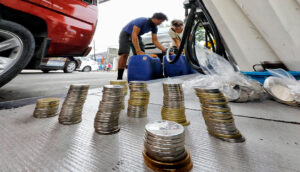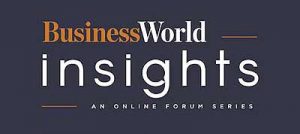BSP likely to pause at next meeting

By Keisha B. Ta-asan, Reporter
THE PHILIPPINE central bank is more likely to keep its key policy rate unchanged than hike by 25 basis points (bps) at its Nov. 16 meeting, its governor said.
Bangko Sentral ng Pilipinas (BSP) Governor Eli M. Remolona, Jr. said on Friday that while a rate hike is always possible, upcoming economic data would still dictate its next policy move.
“I’m not really sure if a 25-bp hike would be justified. There’s a good chance we won’t hike. There’s a good chance we will pause. There’s a chance we might hike but 50 bps is a bit of a stretch,” he told reporters.
The Monetary Board resumed tightening monetary policy as it delivered a 25-bp rate hike in an off-cycle move last Thursday. This brought the key interest rate to a fresh 16-year high of 6.5%.
Rates on the overnight deposit and lending facilities were also raised by 25 bps to 6% and 7%, respectively. The BSP’s first policy move in seven months brought the cumulative rate increases since May 2022 to 450 bps.
Mr. Remolona said a “really bad” development on inflation may prompt the Monetary Board to hike rates by 50 bps at its Nov. 16 meeting, but he does not expect that to happen.
“We’re actually expecting inflation to go down (in October) but not as much as we used to expect. The whole path is elevated, the trajectory looks the same (from before) but it’s now a higher path,” he said in mixed English and Filipino.
Headline inflation quickened to 6.1% in September from 5.3% in August, marking the 18th straight month that inflation exceeded the central bank’s 2-4% target. Year to date, inflation averaged 6.6%.
The BSP sees average inflation at 5.8% for 2023, before easing to 3.5% in 2024 and 3.4% in 2025. However, officials said the BSP will be revising its inflation forecasts on Nov. 16.
Mr. Remolona also noted that inflation may ease to within the 2-4% target “very briefly” in the first quarter of 2024, due to base effects. Inflation peaked at 8.7% in January this year.
However, from March to July, he noted inflation is likely to be above the 2-4% target band.
Aris Dacanay, economist for Association of Southeast Asian Nations (ASEAN) at HSBC Global Research, said the BSP will likely keep borrowing costs steady at the Monetary Board’s two remaining policy-setting meetings on Nov. 16 and Dec. 14.
“After all, core inflation is still treading downwards, which means the BSP’s tight monetary stance is already in the works,” he said in a note.
In September, core inflation eased to 5.9% from 6.1% in August. However, it was still faster than 5% a year earlier. Year to date, core inflation averaged 7.2%.
“Since the off-cycle hike is preemptive in nature, we don’t think the BSP will hike interest rates at its November rate-setting meeting, even if the Fed hikes in November (not HSBC’s base case scenario),” Mr. Dacanay said.
“Nonetheless, the BSP maintained a very hawkish tone and will likely continue doing so — mentioning its openness to resume tightening if inflation continues to be sticky. And the risk of inflation is very much to the upside,” he said.
Mr. Dacanay added that if Executive Order No. 10, which temporarily lowers the tariff rates for key commodity items, will not be extended beyond Dec. 31 this year, it could add 1.4 percentage points to overall inflation.
“That said, our baseline forecast is for headline inflation to breach the BSP’s 2-4% target band in the second quarter of 2024. We don’t think core inflation will follow, but if it does — and the risk is there — then there is a risk that the BSP continues its tightening cycle even further,” he said.
Citi economist for the Philippines Nalin Chutchotitham also sees the Monetary Board keeping policy rates unchanged for the rest of the year and will likely be maintained at the current level through the first half of next year.
“But we see risks of further rate hikes should October CPI (consumer price index) and third-quarter GDP (gross domestic product) suggest there is a need for the BSP to further tighten monetary policy in order to put the brakes on domestic demand and thus demand-pull price pressures,” she said.
The local statistics agency will release October inflation data on Nov. 7 (Tuesday), while third-quarter GDP data will be released on Nov. 9 (Thursday).
“We believe the BSP’s decision to hike by 25 bps (on Thursday), and not 50 bps, suggests that the BSP still has some reservations and is keeping options open, especially if third-quarter GDP disappoints again,” Ms. Chutchotitham added.
Meanwhile, ANZ Research Chief Economist Sanjay Mathur and economist Debalika Sarkar in a note said the BSP may deliver another 25-bp rate increase to 6.75% before the year ends.
ANZ ruled out any chance of policy easing from the BSP in 2024, as inflation is seen to remain elevated through the first half of next year.
Following the BSP’s off-cycle move, BMI Country Risk & Industry Research raised its year-end inflation forecast to 4.7% in 2023 from 4% previously. It now sees next year’s inflation to average 4%, from 3.6%, previously.
“With headline inflation expected to stay higher for longer and the BSP’s still hawkish slant, we now expect policy rates to be hiked once more by 25 bps in November,” BMI said in a note.
However, further monetary tightening “will do little” to help mitigate inflation as the increase in consumer prices were largely supply-side driven.
“We think that inflation will stay elevated until policies aimed at quelling supply-side constraints are implemented. This feeds into our forecast for inflation to average 4% in 2024,” it said.




